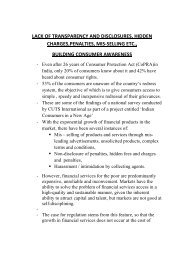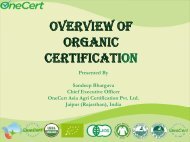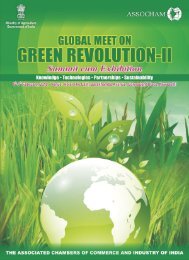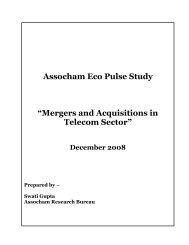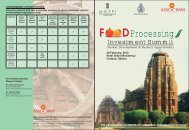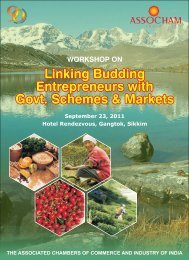Presentation By Dr. A K Rajput - The Associated Chambers of ...
Presentation By Dr. A K Rajput - The Associated Chambers of ...
Presentation By Dr. A K Rajput - The Associated Chambers of ...
You also want an ePaper? Increase the reach of your titles
YUMPU automatically turns print PDFs into web optimized ePapers that Google loves.
<strong>Dr</strong> A K RAJPUT<br />
EXECUTIVE DIRECTOR<br />
ALL INDIA POULTRY BREEDERS ASSOCIATION<br />
ASSOCHAM<br />
Conceptualized by <strong>Dr</strong> Norman Borlaug and green signaled by<br />
Hon’ble Mrs. Indira Gandhi,along with <strong>Dr</strong> M S Swaminathan and<br />
Venkatraman it transformed itself from a starving<br />
nation to an exporter <strong>of</strong> food.<br />
More jobs were created to support revolution<br />
Dams were built which are used in electricity production too.<br />
Grain output <strong>of</strong> 131 million tons in 1978-79. This established<br />
India as one <strong>of</strong> the world's biggest agricultural producers.<br />
Yield per unit <strong>of</strong> farmland improved by more than 30 percent<br />
from 1947.<br />
<strong>The</strong> crop area under HYV varieties grew from 7 per cent to 22<br />
per cent <strong>of</strong> the total cultivated area during the 10 years <strong>of</strong> the<br />
Green Revolution.<br />
Double cropping improved agricultural productivity.
• Ironically, Agriculture employs largest share <strong>of</strong><br />
workforce (52%) but delivers lowest GDP(16%) share<br />
as compared to Service and Industry.<br />
• High agriculture growth also helps mute food<br />
inflation. Yields per hectare <strong>of</strong> food grains, fruits and<br />
vegetables in India are far below global averages. Our<br />
rice yields are one-third <strong>of</strong> China's, and about half <strong>of</strong><br />
Vietnam's and Indonesia's. Even India's most<br />
productive states lag global averages. For example,<br />
Punjab's yield <strong>of</strong> rice in 2010 was 3.8 Metric Ton per<br />
hectare against the global average <strong>of</strong> 4.3 MT. <strong>The</strong><br />
average yield for apples in India (J&K ) is about 11<br />
Ton per acre compared to the US, New Zealand, Israel<br />
or China, where yields range 30-70 MT per acre.<br />
(Source -ET)<br />
<strong>The</strong>re were three basic elements in the method<br />
<strong>of</strong> the Green Revolution:<br />
1. Continued expansion <strong>of</strong> farming areas;<br />
2. Double-cropping existing farmland;<br />
3. Using seeds with improved genetics.
Economic growth and population are the dual<br />
crisis in India.<br />
Hunger and malnutrition continue the<br />
unsolved issues from 1 st to 11 five year plan.<br />
<strong>By</strong> 2035 India population will be more than<br />
China. As India is adding 22million new born<br />
v/s 10 million every year.<br />
In 1960 the cultivable land was .21hectare<br />
per person, which has dropped .08 hectare in<br />
2005.<br />
<strong>The</strong> total food grain production has increased<br />
to 211 million tones in 2006 as compared to<br />
168 million tones in 1991.<br />
<strong>The</strong> Green Revolution in India started in the late<br />
1960s and with its success India attained food selfsufficiency<br />
within a decade. However, this first „wave‟<br />
<strong>of</strong> the Green Revolution was largely confined in wheat<br />
crop and in northern India such as Punjab, resulting<br />
in a limited contribution to overall economic<br />
development <strong>of</strong> the country.<br />
On the contrary, the agricultural growth in the 1980s<br />
(the second „wave‟ <strong>of</strong> the Green Revolution) involved<br />
almost all the crops including rice and covered the<br />
whole country, it enabled to raise rural income and<br />
alleviate rural poverty substantially.<br />
Such a rise <strong>of</strong> rural India as a „market‟ for nonagricultural<br />
products and services was an important<br />
pre-requisite for the rapid economic growth based on<br />
non-agricultural sectors‟ development in India after<br />
the 1990s.
<strong>The</strong> Indian Council for Agricultural Research<br />
(which was established by theBritish in 1929<br />
but was not known to have done any<br />
significant research) was reorganized in 1965<br />
and then again in 1973. It developed new<br />
strains <strong>of</strong> high yield value (HYV) seeds, mainly<br />
wheat and rice but also millet and corn. <strong>The</strong><br />
most noteworthy HYV seed was the K68<br />
variety for wheat. <strong>The</strong> credit for developing<br />
this strain goes to <strong>Dr</strong>. M. P.Singh who is also<br />
regarded as the hero <strong>of</strong> India’s first Green<br />
revolution.<br />
<strong>The</strong>re are obvious reasons for wishing corporate participation in India’s Second<br />
Green revolution.<br />
First, the triumvirate, which guaranteed the success <strong>of</strong> the first Green Revolution,<br />
may be difficult to form Leadership issues and party politics will make any<br />
government initiative difficult to succeed.<br />
Second, efficient delivery <strong>of</strong> services will be the key to higher agricultural output.<br />
Governments, especially the democratic governments, are not geared for efficiency<br />
and effective delivery <strong>of</strong> any services. Current food marketing and storage system all<br />
owned by the government (FCI) is key example. Rough estimates indicate that<br />
anywhere from 20 to 30% <strong>of</strong> the food is spoiled, before it hits the dinner table.<br />
Thirdly; Multinationals would prefer to deal with the private sector than with<br />
government <strong>of</strong>ficials. Private sector in India is very willing to enter this pr<strong>of</strong>itable<br />
sector. A joint venture between Bharti Telco’s Milltal is making foray into export <strong>of</strong><br />
fresh fruits & vegetables.
India transformed itself from a starving<br />
nation to an exporter <strong>of</strong> food. This earned<br />
admiration for India in the comity <strong>of</strong> nations,<br />
especially in the Third world.<br />
<strong>The</strong> Green Revolution was one factor that<br />
made Mrs. Indira Gandhi a very powerful<br />
political force in India (it would however be<br />
wrong to say that it was the only reason.)<br />
<strong>The</strong> Second Green Revolution <strong>of</strong> boosting foodgrain<br />
output in India to 400 million tons in next 15<br />
years is need <strong>of</strong> the day. Its achieving is not very<br />
difficult. Rather it is achievable if mindset on<br />
introducing newer technology is changed. India has<br />
to whole heartedly embrace the new technology.<br />
Private sector is better suited to deliver results<br />
than government managed schemes. Governments<br />
on the other hand can play a key role in expending<br />
irrigation schemes and managing water resources.
With the reduction <strong>of</strong> land holding in India,the<br />
farmers need to diversify in to the Agrirelated<br />
activities such as :-<br />
1.POULTRY FARMING<br />
2.DAIRY FARMING<br />
3.SHEEP AND GOAT REARING<br />
4.PIGGARY FARMING<br />
5. BEE KEEPING<br />
6. FISHERY<br />
7. SERICULTURE etc.<br />
India is 3 th Largest producers <strong>of</strong> eggs and 5 th<br />
largest producer <strong>of</strong> poultry meat globally<br />
Organized sector contributes 70% <strong>of</strong> total<br />
output.<br />
It contribute about Rs 35,000 crores to the<br />
national income.<br />
Total focus in rural area therefore go along<br />
with Agriculture Sector.
Poultry scenario in India<br />
Till late 80’s Poultry activities were dormant<br />
In the early 90’s Poultry Industry came into<br />
focus.<br />
Broiler Industry was only a mere 300 crores<br />
rupees size in year 1990 and is already<br />
9000 Crores now.<br />
Further it is about to grow to the level <strong>of</strong><br />
21,000 Crores in year 2012<br />
• This Phenomenal growth is mainly due to<br />
one single reason…..<br />
CONTRACT POULTRY<br />
FARMING
HEALTHY BROILERS<br />
ARE PRODUCED<br />
BY<br />
CONTRACT FARMING
POULTRY -PAST<br />
Until the 90’s individual farmer was the<br />
owner for fortunes or misfortunes.<br />
<strong>The</strong> production volume was less<br />
• Per capita consumption was less<br />
• Too many pr<strong>of</strong>it centres such as Chick, Feed,<br />
Transport , middlemen and others ….<br />
PAST EXPERIENCE OF POULTRY<br />
FARMERS<br />
• Farmers were not able to make any money<br />
for following reasons in the past.<br />
• Feed Mills operated Separately,<br />
• Breeder and chicks were from different<br />
companies/firms<br />
• Distributors <strong>of</strong> Feed , chicken and other raw<br />
materials were working independently<br />
• Too many middlemen in purchase or<br />
marketing
INTEGRATION MEANS CONTRACT<br />
FARMING<br />
• <strong>The</strong> contract farming method was<br />
introduced in India by Suguna Group in<br />
Coimbatore with the help <strong>of</strong> willing farmers<br />
to come into contract farming.<br />
• <strong>The</strong> farmer becomes a working partner with<br />
good will<br />
1990 by SUGUNA<br />
• Farmers opted for contract farming<br />
which was started by Suguna in 1990<br />
Till 1995 in Tamilnadu<br />
• Till year 1995 contract farming was adopted in<br />
Tamil Nadu only<br />
1995 to 2000 in Karnataka<br />
• Between 1995 and 2000 contract farming<br />
spread to Karnataka<br />
From 2000 onwards in AP, Maharashtra & gujarat<br />
• After 2000 it spread over to the entire southern<br />
and western parts <strong>of</strong> India.<br />
Presently spreading in West Bengal & Orissa
DUAL EFFORTS<br />
• INTEGRATOR<br />
• TRIES TO GIVE QUALITY CARE<br />
FOR THE BIRDS AND THE<br />
FARMER WITH VALUE ADDED<br />
SERVICES SUCH AS<br />
(1) CONSTANT R&D IN ALL<br />
ASPECTS<br />
(2) DISEASE PREVENTION<br />
(3) PERIODICAL TRAINING TO<br />
BOTH FARMERS & STAFF<br />
FARMER<br />
TRIES HIS BEST FOR LOW<br />
FCR, HIGH LIVABILITY ,<br />
HIGH WEIGHT GAIN<br />
AND THEREBY LOW<br />
PRODUCTION COST<br />
WHICH RESULTS IN HIS<br />
HIGHER GROWING<br />
CHARGES<br />
FUTURE SCENARIO<br />
• Mckinsey Report predicts two industries which are<br />
going to prosper until and after year 2010.One<br />
among the two is Poultry industry.the other is flour.<br />
• Already Indian Poultry industry is growing @ 13%<br />
per year<br />
• Consumption rate is also growing steadily.<br />
400 grms<br />
In 1990<br />
1900 grams in India<br />
In 2007<br />
& 3600 grams in India<br />
In 2010
FUTURE VISION<br />
• 3600 gram per capita consumption in<br />
domestic front IN YEAR 2012<br />
• Converting the poultry meat into<br />
Frozen meat,<br />
Portions<br />
Marinated<br />
Ready to Eat<br />
• 10% <strong>of</strong> the Nation’s production for Exports<br />
OUR EXPECTATIONS<br />
• Institutions like NABARD to come forward to<br />
assist financially.<br />
• Government Departments to extend Grants,<br />
subsidies etc.
CHANGE IN END PRODUCT<br />
• Now that all Metros are in the process <strong>of</strong><br />
banning live bird slaughtering in city limits<br />
the consumers have started switching over<br />
to frozen/chilled meat .<br />
• A welcome measure<br />
• Hygienic<br />
• Pollution free<br />
• In future ready to cook frozen/chilled<br />
chicken will be the choice <strong>of</strong> consumers
Chicken Slaughter Plant<br />
06/02/11<br />
29<br />
Chicken Meat Selling Shop<br />
06/02/11<br />
30
• One day we have to commit to Indian<br />
consumers high quality hygiene meat to be<br />
provided<br />
• It can be possible by way <strong>of</strong> education and<br />
regulation<br />
• It is not possible by one stage by conversion<br />
• Gradual up-gradation is needed
STAGE 1<br />
• In and around Metros, meat processing zones / park to be<br />
created<br />
• After creation <strong>of</strong> such, through education and regulation, we<br />
have to create positive situation. It will take minimum 3 – 5<br />
years <strong>of</strong> time<br />
• As like oil, the chicken meat to be packed and marketed<br />
• Slaughtering in the live bird shops to be gradually upgraded<br />
• Across the country, all the Corporations have to<br />
follow the Metros, it will take 4 – 8 years <strong>of</strong> the<br />
time completely.
– Across the country, we have to sell only plant<br />
slaughtered meat. This can be in 8 – 10<br />
years<br />
– Live chicken at retail level, we have to come<br />
out<br />
EXPORT POTENTIALS<br />
• <strong>The</strong> gulf countries who are the second largest<br />
poultry meat consumers are importing a large<br />
quantity <strong>of</strong> Poultry meat<br />
• <strong>The</strong> largest exporter to gulf is Brazil<br />
• But in terms <strong>of</strong> <strong>of</strong> distance we are nearer .<br />
• Hence we have a good chance to match this<br />
requirement
Why INTEGRATION<br />
• For matching this requirement we are<br />
bound to produce more broiler birds and<br />
convert them as frozen meat.<br />
• If we need to produce more birds ,<br />
INTEGRATION gives a good support.<br />
• It opens venue for more employment<br />
• Exports yield foreign exchange for our<br />
nation.<br />
CSR<br />
• Unlike in any other Industry <strong>The</strong> Integration<br />
in Broiler Industry brings in the Corporate<br />
Social Responsibility in itself
Let us think in the following<br />
lines<br />
• A green revolution for – Agricultural<br />
prosperity<br />
• An Operation Flood for –MILK self sufficiency<br />
• Now a pink Revolution protein rich food for<br />
Indian undernourished.<br />
Let as all join together<br />
and give our share<br />
in building a prosperous &<br />
healthy<br />
INDIA
9313940544<br />
THANK YOU<br />
DR A K RAJPUT<br />
EXECUTIVE DIRECTOR<br />
ALL INDIA POULTRY BREEDERS<br />
ASSOCIATION<br />
MOB.



